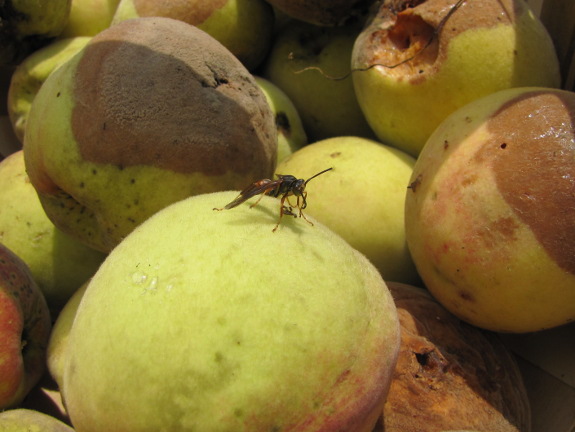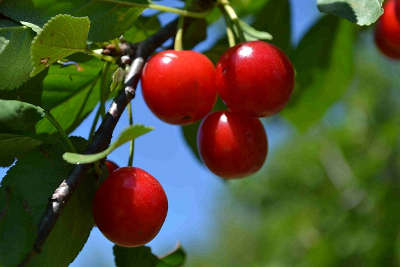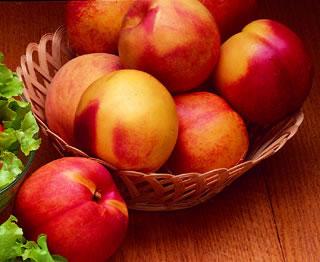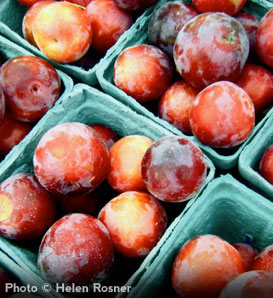
No-spray stone fruits
 At least in our area, stone
fruits can be very problematic because they succumb to the fungal
disease brown rot.
In addition, many of them tend to lose flowers during frosts that come
behind spring thaws, so you may spend several years watching a
beautifully trained peach tree bloom without harvesting any
fruits. Assuming you don't have just the right microclimate to
keep them happy (early morning sun to dry the dew, low humidity in the
summer, and a full-sun site that's shaded during the winter),
you're once again stuck choosing varieties that will handle your
conditions without the necessity of chemical intervention.
At least in our area, stone
fruits can be very problematic because they succumb to the fungal
disease brown rot.
In addition, many of them tend to lose flowers during frosts that come
behind spring thaws, so you may spend several years watching a
beautifully trained peach tree bloom without harvesting any
fruits. Assuming you don't have just the right microclimate to
keep them happy (early morning sun to dry the dew, low humidity in the
summer, and a full-sun site that's shaded during the winter),
you're once again stuck choosing varieties that will handle your
conditions without the necessity of chemical intervention.
 Sour cherries
are perhaps the most disease-resistant of the stone fruits, especially
if you select a variety like English Morello or Meteor. I've also
read about Mongolian-cross bush cherries (Valentine, Carmine Jewel,
Romeo, Juliette, Rose, and Crimson Passion), which are reputed to have
big fruits with lots of sugar, to be tolerant of clay soil, and to
fruit by the fifth year. Unfortunately, the sweet
cherries
I adore are very prone to getting frost-bitten, to
losing their fruits to brown rot, and to perishing in clay. (We
ripped out our dwarf sweet cherry after the Japanese beetles ate all
the leaves multiple years in a row and the few fruits rotted
away.) If you live in a damp climate like ours and have had good
luck with a sweet cherry, I'd love to hear about it.
Sour cherries
are perhaps the most disease-resistant of the stone fruits, especially
if you select a variety like English Morello or Meteor. I've also
read about Mongolian-cross bush cherries (Valentine, Carmine Jewel,
Romeo, Juliette, Rose, and Crimson Passion), which are reputed to have
big fruits with lots of sugar, to be tolerant of clay soil, and to
fruit by the fifth year. Unfortunately, the sweet
cherries
I adore are very prone to getting frost-bitten, to
losing their fruits to brown rot, and to perishing in clay. (We
ripped out our dwarf sweet cherry after the Japanese beetles ate all
the leaves multiple years in a row and the few fruits rotted
away.) If you live in a damp climate like ours and have had good
luck with a sweet cherry, I'd love to hear about it.
Peaches are more tolerant of
wet feet than cherries, but are very prone to lose fruit to bacterial
spot and brown rot. Disease-resistant varieties include:
- Early Redhaven
- Ernie's choice --- reputed to taste like a nectarine
- Garnet Beauty
- Harbrite
- Harcrest
- Harrow Beauty
- Harrow Diamond
- Glohaven
- Elberta
- Madison
- New Haven
- Raritan Rose
 Nectarines
are simply a hairless peach, but most are especially prone to insect
and disease damage (as we found in our own garden). However
Hardired, Mericrest, Midglo, and RedGold have at least some disease
resistance.
Nectarines
are simply a hairless peach, but most are especially prone to insect
and disease damage (as we found in our own garden). However
Hardired, Mericrest, Midglo, and RedGold have at least some disease
resistance.
Although the beautiful
golden fruits of apricots
always tempt me in nursery catalogs, it sounds like I'd be better off
keeping my distance if I don't want to baby trees with little
reward. Of all the stone fruits, apricots are most likely to lose
their ultra-early flowers to frosts, they have no tolerance for wet
feet, and they get all the usual stone fruit diseases. Selecting
late bloomers like Alfred, Goldcot, Harcot, Harglow, Hargrand,
Harlayne, Harogen, Jerseycot, Precious, and Sugar Pearls will at least
weigh the odds in your favor.
(By the way, in case
you're wondering why so many frost- and
disease-resistant stone fruits have names starting with "Har", these
were developed at the Harrow Research Station in Ontario.)
 Finally, we come to the plums, which are really two
species --- European plums (Prunus
domestica) and
Asian plums (Prunus
salicina).
The latter are less hardy, with zone 6 being their most northern
limit, require light soil, and need warm, dry summers. European
plums are better for most low-key gardeners since they can handle clay
and bloom later, so they skip some spring frosts, but they're less
likely to be disease resistant (with Seneca and Imperial Epineuse being
the only resistant varieties I saw listed). Disease-resistant
Asian plums include:
Finally, we come to the plums, which are really two
species --- European plums (Prunus
domestica) and
Asian plums (Prunus
salicina).
The latter are less hardy, with zone 6 being their most northern
limit, require light soil, and need warm, dry summers. European
plums are better for most low-key gardeners since they can handle clay
and bloom later, so they skip some spring frosts, but they're less
likely to be disease resistant (with Seneca and Imperial Epineuse being
the only resistant varieties I saw listed). Disease-resistant
Asian plums include:
- AU Roadside
- AU Rosa
- Methley (which is what we have, but it's not thriving in our clay)
- Satsuma
You can also check out
the more cold hardy Asian-American crosses, as
long as you're willing to work harder to get them pollinated.
Disease-resistant and hardy varieties include Alderman and Superior.
As usual, I'd love to
hear about the stone fruits you've grown without
chemical intervention. Be sure to mention your growing zone and
general region since many varieties do much better in certain areas
than others. I have a couple of spots that I might be able to
cram another tree into, and your tips will help me decide who makes the
cut.
Next week, we'll finish
up The
Holistic Orchard
by talking about
berries, but in the meantime you might enjoy previous posts about beginning
a holistic orchard, techniques
for designing a holistic orchard, orchard
soil health, managing
fungi in the orchard, and disease-resistant
pears. After that, we'll take a week off, then will start
reading Joel Salatin's Folks
This Ain't Normal,
which won the vote by a landslide!
Want more in-depth information? Browse through our books.
Or explore more posts by date or by subject.
About us: Anna Hess and Mark Hamilton spent over a decade living self-sufficiently in the mountains of Virginia before moving north to start over from scratch in the foothills of Ohio. They've experimented with permaculture, no-till gardening, trailersteading, home-based microbusinesses and much more, writing about their adventures in both blogs and books.
Want to be notified when new comments are posted on this page? Click on the RSS button after you add a comment to subscribe to the comment feed, or simply check the box beside "email replies to me" while writing your comment.

You should look into some of the native trees. The Chickasaw plums do really well for me in fl. You have to look hard, but you can find dozens of varieties. I grow a Gurthie(?), nonsuckering, round orange flesh fruit, very nice. One called Strawberry, small fruit, big seed, but red flesh and amazing flavor. And Ping, the skin stays greenish, and very tart, the flesh is light and sweet. It has two seeds in most of the fruit.
If your looking for cherries, again your going to have to look hard, try looking for the native Black cherries. They're very good in their own wild state, but I know there are people working with them to improve size and what not. Maybe find some surplus experiments.
May take some effort, but these trees are worth looking into for the adaptability and resistances they haves.
I also grow a plum called Scarlet Beauty, a sturdy low chill plum high on flavor. I have sent some to Tennessee before, and they supposedly can take the cold quite well. And Sharcarpara(?)apricots, very Sweet white flesh, and they do flower a bit later for me.
We lived in zone 6A in Arkansas, in the middle of rice country. The area is very humid. We had clay but also drainage. Odd but I guess due to New Madrid there are sand pockets under some of the clay fields. The home we purchased was over 100 years old and had 4 apricot trees on the city lot. From what I learned the former owners had purchased it in the 1930s. They planted the apricot trees from seeds/seedlings their family trees. These trees/seeds had been in the family for generations - as the family moved to the "west" from the Atlantic, to Georgia and eventually Arkansas they planted these trees. A granddaughter came to our home to get seeds for her home in Oregon. She liked the idea that the family tree had finally made it from coast to coast.
Anyway - these trees were/are over 50 years old - the extension agent said he did not think any apricot lived that long! But there they were and obviously old. The oldest two died in the ice storm but the youngers (by only a few years) are still producing. They are bi-annual with a huge crop of smaller fruit followed the next year by a light crop. Perhaps if we thinned it would be more even but they were very tall trees. We never sprayed and did not seem to have any troubles with insects or brown rot. The large, more sweet fruited tree is one of the ones that died, the others still produce. I would not say they are good for eating out of hand but they do make a very nice jam or jelly. Perhaps if we had fed them compost that might make a difference in flavor? We were just extremely happy to have fruit without a lot of effort.
We have since moved but still own the house. If it is a fruiting year would you be interested in seeds?
Stephanie --- What a fascinating story! I'm sorely tempted by your kind offer, but am really only a fresh-fruit eater --- no jams or jellies here. So I guess I'll have to pass.
(I'm appreciating the other variety advice too!)